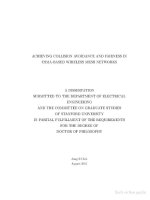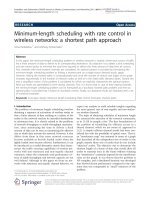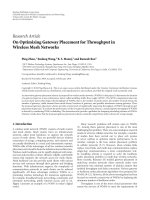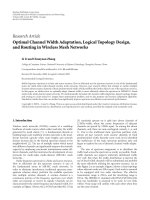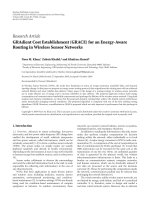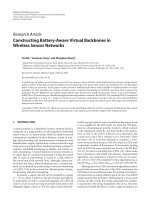Association control in wireless mesh networks
Bạn đang xem bản rút gọn của tài liệu. Xem và tải ngay bản đầy đủ của tài liệu tại đây (1.04 MB, 163 trang )
ASSOCIATION CONTROL IN WIRELESS MESH
NETWORKS
YU JINQIANG
(B.Eng.(1
st
Class Hons.), NUS)
A THESIS SUBMITTED
FOR THE DEGREE OF DOCTOR OF PHILOSOPHY
NUS GRADUATE SCHOOL FOR INTEGRATIVE SCIENCES AND
ENGINEERING
NATIONAL UNIVERSITY OF SINGAPORE
2015
DECLARATION
I hereby declare that the thesis is my original work
and has been written by me in its entirety.
I have duly acknowledged all the sources of information
which have been used in the thesis.
This thesis has also not been submitted for any
degree in any university previously.
Yu Jinqiang
3 February 2015
i
Acknowledgements
First and foremost, I would like to express my heartfelt gratitude to my
supervisor Prof. Wong Wai-Choong, Lawrence, for his continuous guidance and
support during my PhD study. His insights, suggestions, and valuable feedback have
helped me shape my research skills and extended my dimensions of thinking. His
enthusiasm, encouragement, patience, and faith in me throughout have been
extremely inspiring and helpful. He was always available for my questions and has
generously devoted his time and efforts to this thesis, without which its completion
would not be possible.
I would also like to thank my thesis advisory committee (TAC) members, Prof.
Hari Krishna Garg and Prof. Akkihebbal L. Ananda, for their time and efforts in
assessing my research work, for their valuable suggestions and critical yet beneficial
comments in our TAC meetings.
I would like to thank NUS Graduate School for Integrative Sciences and
Engineering for financially supporting my study through NGS Scholarship.
I would like to thank my friends in IDMI Ambient Intelligence Lab for all the
great times we have shared. I am thankful to Mr Song Xianlin and Ms Guo Jie, for
providing assistance in carrying out my research.
I am deeply thankful to my family for their love, support, and sacrifices. I
dedicate this thesis to my parents, Yu Liming and Wang Shulian, who have devoted
unparalleled love and care to me. Most importantly, my very special thanks and love
go to my dear wife He Yanran, who has made the days with her the best of my life.
ii
Contents
Acknowledgements i
Contents ii
Summary vi
List of Tables viii
List of Figures ix
List of Abbreviations xi
List of Symbols xiii
Chapter 1: Introduction 1
1.1. Association Mechanisms in WLANs 1
1.2. Wireless Mesh Network Architecture 3
1.2.1. The General WMNs 3
1.2.2. The WMNs in the Thesis 5
1.3. Motivation and Objectives 6
1.3.1. Heuristic Association 6
1.3.2. Optimal Association 8
1.4. Contributions and Organization of the Thesis 10
Chapter 2: Literature Review 12
2.1. WLAN Association Schemes 12
2.1.1. Distributed Approaches for WLANs 12
iii
2.1.2. Centralized Approaches for WLANs 14
2.2. WMN Association Schemes 16
2.2.1. Heuristic Approaches for WMNs 16
2.2.2. Optimization Approaches for WMNs 18
Chapter 3: A Cross-Layer Association Control Scheme for WMNs 19
3.1. Introduction 19
3.2. The Cross-layer Association Control Scheme 20
3.2.1. Association Metrics 20
3.2.2. Access Weight Adjustment Scheme 22
3.2.3. Procedure of the Proposed Association Scheme 23
3.3. Performance Evaluation 24
3.3.1. Experiment 1: Grid Topology 25
3.3.2. Experiment 2: Random Topology 30
3.4. Conclusion 33
Chapter 4: Mobility-aware Reassociation Control in WMNs 34
4.1. Introduction 34
4.2. MARA: Mobility-Aware Reassociation Control 36
4.3. Performance Evaluation 40
4.3.1. Performance of MARA 42
4.3.2. Adaptability of MARA 45
4.3.3. Random Topology 46
4.4. Conclusion 47
Chapter 5: Optimal Association in WMNs 48
iv
5.1. Introduction 49
5.2. Network Model 50
5.3. Optimal Joint Association and Bandwidth Allocation Algorithm 53
5.3.1. Optimization Problem Formulation 53
5.3.2. Introducing the Approximation Algorithm 55
5.3.3. Optimization Problem Relaxation 56
5.3.4. Rounding Algorithms 57
5.3.5. Integral Bandwidth Allocation 63
5.4. Approximation Ratio Analysis and Improvement 64
5.4.1. Approximation Ratio Analysis 64
5.4.2. Approximation Ratio Improvement Algorithms 68
5.5. Performance Evaluation 73
5.5.1. Simulation Setting 73
5.5.2. Performance of Association Algorithms and Fairness Objectives 74
5.5.3. Comparison of the Rounding Algorithms 83
5.6. Conclusion 88
Chapter 6: Utility Fairness via Association Control in WMNs 89
6.1. Introduction 89
6.2. Utility Fair Bandwidth Allocation and Association Control 90
6.2.1. Utility Fairness 90
6.2.2. Problem Formulation 91
6.2.3. Approximation Algorithm 92
6.3. Performance Evaluation 93
v
6.3.1 Comparison of the Association Algorithms 93
6.3.2. Tradeoff between Efficiency and Fairness 96
6.4. Conclusion 98
Chapter 7: A Network Resource Management Framework for WMNs 100
7.1. Introduction 100
7.2. Network Model 104
7.3. A Network Resource Management Framework for WMNs 108
7.3.1. Utility-based Bandwidth Allocation 109
7.3.2. Joint Channel Assignment and Bandwidth Allocation 111
7.3.3. The Resource Management Framework 115
7.4. Performance Evaluation 116
7.4.1. Performance of the Local-clique-based Modeling Method 119
7.4.2. Performance of JCBA 122
7.5. Conclusion 129
Chapter 8: Conclusion and Future Works 131
8.1. Conclusion 131
8.2. Future Works 132
Bibliography 136
List of Publications 145
vi
Summary
The Wireless Mesh Network (WMN) is quickly emerging as a promising
solution for low-cost ubiquitous network access. Due to its special characteristics,
existing wireless network resource management algorithms need to be redesigned to
fully release WMN’s potential. Association control is one of them. In this thesis, we
investigate association control mechanisms for WMNs from various aspects. In
WMNs, a mobile station (STA) associates with one of the nearby mesh access points
(MAPs) that are connected to a wireless multi-hop backhaul. Unlike the wired
backhaul in the conventional Wireless Local Area Networks (WLANs), the wireless
backhaul enables easy network deployment, but at the expense of limitations such as
limited capacity, inter-flow and intra-flow interferences, and unfairness in the
backhaul contention, etc. The association between MAPs and STAs determines the
network logical topology and has significant impact on load distribution, aggregate
throughput, and user fairness. The state-of-the-art association metrics proposed for
WMNs still adopt the design methodology from WLANs and cannot make good use
of the network resource. In addition, there are very few previous works on optimal
association in WMNs. Therefore, in this thesis, we propose several innovative
association control schemes including both distributed association-metric-based
heuristics and centralized optimization-based algorithms, to improve network
performance of WMNs.
We first propose two practical heuristic schemes: a cross-layer heuristic
association scheme that is able to effectively allocate more STAs to the good-
backhaul MAPs and at the same time avoid over-congestion at these MAPs, and a
vii
mobility-aware reassociation control scheme that is able to prolong mobile STAs’
association time with the good-backhaul MAPs and discover network dynamics in a
smart and timely way without interrupting normal communication too much. Then we
formulate the problem of optimal joint association and bandwidth allocation in
WMNs, considering three types of fairness objectives: max-min fairness, proportional
fairness, and utility-based fairness. We propose two approximation algorithms for the
optimization problems and analyse the theoretical approximation ratios as well as the
corresponding ratio improvement algorithms. As association control, MAP channel
assignment, and STA bandwidth allocation are closely related to each other, we
propose a resource management framework that jointly considers the three subjects
and further improves WMNs performance. In the framework, we propose an efficient
local-clique based network modeling method whose performance is almost identical
to that of the exponential-time optimal algorithms. We demonstrate the superior
performance of the proposed schemes against the state-of-the-art schemes via
simulations using ns-3 simulator as well as our customized simulator.
viii
List of Tables
Table 4-1: AVERAGE NUMBER OF SCANS CONDUCTED PER STA 45
Table 4-2: IMPACT OF THE MEAN LOCALIZATION ERROR 46
Table 5-1: LINK RATE MODEL FOR 802.11N WITH ONE SPATIAL STREAM
ON 20MHZ CHANNELS 74
Table 5-2: AGGREGATE THROUGHPUT AND JAIN’S FAIRNESS INDEX
RESULTS 81
Table 5-3: APPROXIMATION RATIO RESULTS 88
Table 7-1: NOTATIONS 108
Table 7-2: LINK RATE MODEL FOR ACCESS LINKS 118
Table 7-3: AGGREGATE THROUGHPUT AND FAIRNESS INDEX OF THE CA-
AC SCHEMES 123
Table 7-4: PERFORMANCE OF THE CA SCHEMES 124
Table 7-5: PERFORMANCE FOR THE NETWORKS OF HIGHER NODE
DENSITY 128
ix
List of Figures
Figure 1.1: Wireless mesh architecture. 4
Figure 3.1: 12-MAP grid topology. 25
Figure 3.2: Effect of the access weight. 27
Figure 3.3: Association results under different association metrics. 29
Figure 3.4: Aggregate throughput in the grid MAP topology. 30
Figure 3.5: Average packet delay in the grid MAP topology. 30
Figure 3.6: Aggregate throughput in the random MAP topology. 32
Figure 3.7: Average packet delay in the random MAP topology. 32
Figure 3.8: Fairness index in the random MAP topology. 33
Figure 4.1: The grid MAP topology. 41
Figure 4.2: Aggregate throughput in the grid topology. 43
Figure 4.3: Average end-to-end packet delay in the grid topology. 43
Figure 4.4: Packet loss at the access networks and at the backhaul. 44
Figure 4.5: Average association time with 3 MAP classes. 44
Figure 4.6: Aggregate throughput under different moving speeds. 46
Figure 4.7: Aggregate throughput in the random topology. 47
Figure 4.8: Average end-to-end packet delay in the random topology. 47
Figure 5.1: A 5-MAP backhaul routing tree. 51
Figure 5.2: Algorithm JABA. 55
Figure 5.3: Algorithm BGR. 58
Figure 5.4: Approximation ratio improvement algorithm for LFR. 71
Figure 5.5: Approximation ratio improvement algorithm for BGR. 72
x
Figure 5.6: Per-STA bandwidth performance of the association protocols. 81
Figure 5.7: Per-STA bandwidth performance for large networks. 83
Figure 5.8: Performance of the rounding algorithms. 86
Figure 5.9: Per-STA bandwidth standard deviation, hotspot topology, LFR 87
Figure 6.1: Per-STA bandwidth performance of the association protocols. 95
Figure 6.2: Efficiency index and fairness index. 97
Figure 6.3: Per-STA bandwidth performance for varying α value. 98
Figure 6.4: STA bandwidth and MAP backhaul cost 98
Figure 7.1: An association control and channel assignment example. 101
Figure 7.2: A clique modeling example. 107
Figure 7.3: Algorithm UBa 110
Figure 7.4: Algorithm JCaBa. 112
Figure 7.5: Algorithm JCBA 115
Figure 7.6: Network topology examples 117
Figure 7.7: Performance of the clique modeling methods 121
Figure 7.8: Performance of the CA-AC schemes. 124
Figure 7.9: Performance of UBa with different α value. 129
xi
List of Abbreviations
AC Association Control
AP Access Point
A.R. Approximation Ratio
ARI Approximation Ratio Improvement
BA Bandwidth Allocation
BGR Bipartite Graph Rounding
CA Channel Assignment
CAETT Contention Aware Expected Transmission Time
CCA Clear Channel Access
CFP Contention-Free Period
CSMA/CA Carrier Sense Multiple Access with Collision Avoidance
dBm Decibel-milliwatts
DCF Distributed Coordination Function
ETT Expected Transmission Time
GAP Generalized Assignment Problem
HWMP Hybrid Wireless Mesh Protocol
JABA Joint Association and Bandwidth Allocation
JCaBa Joint Channel assignment and Bandwidth allocation
JCBA
Joint Channel assignment, Bandwidth allocation, and Association
control
LAETT Load Aware Expected Transmission Time
LFR Largest Fraction Rounding
xii
MAC Multiple Access Control
MARA Mobility Aware ReAssociation control
MAP Mesh Access Point
MM Max-Min fairness
MUMP Maximum Utility Matching Problem
PF Proportional Fairness
QoS Quality of Service
RSSI Received Signal Strength Indicator
S.D. Standard Deviation
SNR Signal-to-Noise Ratio
SS Strongest Signal
STA Mobile station
TDMA Time Division Multiple Access
UDP User Datagram Protocol
VC Vertex Coloring
WLAN Wireless Local Area Network
WMN Wireless Mesh Network
xiii
List of Symbols
Symbol Semantics
α
The parameter that controls the priority of fairness.
α
LFR
The approximation ratio of JABA-LFR algorithm.
α
BGR
The approximation ratio of JABA-BGR algorithm.
i
The channel idleness ratio of MAP i.
t
The channel idleness ratio threshold.
A
The weight assigned to the access link cost.
Max
The maximum access weight.
Min
The minimum access weight.
AC
ij
The access link airtime cost between MAP i and STA j.
AppRatio(i) The approximation ratio of MAP i.
b
ij
The bandwidth allocated to STA j to communicate with MAP i.
b
j
The bandwidth of STA j.
b
min
The minimum STA bandwidth in a feasible bandwidth allocation.
B
A STA bandwidth allocation vector {b
i
}.
B
i
The bandwidth allocated to MAP i.
B
lower
The parameter controlling the lower bound of STA bandwidth.
B
upper
The parameter controlling the upper bound of STA bandwidth.
BC
i
The backhaul airtime cost of the multi-hop path from MAP i to
the portal.
BCG
A backhaul conflict graph.
BG(X’)
A bipartite graph constructed according to the fractional
association X’.
xiv
C
A channel assignment vector {c
i
}.
CH
The set of all non-overlapping channels {ch
1
, ch
2
, …, ch
N-CH
}.
D
i,t
The distance to MAP i measured by a STA in a scan t.
D
th
The distance threshold above which a STA is considered moving
towards a MAP.
F
Jain’s fairness index.
f
utility
(B) The utility objective function value of the bandwidth allocation B.
f
AP
(X,B) The objective function value of iAP and fAP with input (X,B).
i
A MAP.
IntR
Interference range.
j
A STA.
k
A clique.
k(i)
The set of local access cliques at MAP i.
k(l)
the set of local maximal cliques at link l.
K
A
The set of access link cliques.
K
B
The set of all backhaul link cliques.
K
cfl
(l) All maximal cliques among the links in L
cfl
(l).
L
B
The set of the backhaul links.
L
cfl
(l) The set of links that are conflict with link l.
l
ij
The access link between MAP i and STA j.
LinkRateRatio
The ratio of the backhaul link rate over the access link rate.
load
itf
(i,i’) The traffic that is carried by MAP i’ and interferes with MAP i.
load
self
(i) The total traffic to be carried by MAP i for its associated STAs.
load
t-self
(i) The total self-load of MAP i and its interfering MAPs in M
ift
(i).
load
t-w-itf
(i) The metric of total weighted interference for MAP i.
xv
M
The set of all MAPs {i}.
M(j)
The set of MAPs that have fractional association with STA j.
M
IR
(i) The set of MAPs that are within the interference range of MAP i.
M
itf,1
(i) The set of MAPs that are within the interference range of MAP i.
M
itf,2
(i)
The set of MAPs that are outside the interference range of MAP i,
but have access links interfering with i.
M
itf
(i)
The set of MAPs that have access links interfering with MAP i on
the same channel.
MC
A
The optimal set of all maximal cliques of the access links.
MC
B
The optimal set of all maximal cliques of the backhaul links.
N
0
The receiver noise in dBm.
P
l
(d) The path loss in dB for path length d.
P
Rx
The received power in dBm.
P
Tx
The transmitting power in dBm.
path(i)
The set of links on the routing path between MAP i and the portal.
Q
itf
(i)
The set of all maximal cliques of MAPs that interfere with MAP i
and mutually interfere with each other.
r
ij
The access link rate between MAP i and STA j.
r
ki
The effective backhaul link rate for MAP i in backhaul clique k.
r
ij
a
The estimated achievable data rate between MAP i and STA j.
S
The set of all STAs {j}.
S(i)
The set of STAs that are fractionally associated with MAP i.
S
IR
(i) The set of STAs that are within the interference range of MAP i.
S
TR
(i) The set of STAs that are within the transmission range of MAP i.
scv(i,j)
The sorting criteria variable used by MAP i to sort the STAs
()
j
Si
.
T
Interval
The STA scan interval.
xvi
T
Interval_Max
The maximum scan interval allowed.
T
Interval_Min
The minimum scan interval allowed.
T
TC
The total association cost improvement threshold.
T
TC_Low
The TC improvement threshold when a STA is moving towards
good-backhaul MAPs.
T
TC
_
Middle
The TC improvement threshold when a STA is static.
T
TC_High
The TC improvement threshold when a STA is moving towards
poor-backhaul MAPs.
TC
ij
Total association cost between MAP i and STA j.
TransR
Transmission range.
U
α
(b
j
) The utility of STA j’s allocated bandwidth.
X
A STA-MAP association matrix {x
ij
}.
(',')
X
B
An optimal fractional JABA solution.
ˆˆ
(',')
X
B
An approximated integral JABA solution.
**
ˆ
ˆ
(,)
X
B
An optimal integral JABA solution.
x
ij
The association between MAP i and STA j.
y
ki
Indicating whether backhaul clique k is on MAP i’s backhaul
path.
1
Chapter 1: Introduction
1.1. Association Mechanisms in WLANs
IEEE 802.11 Wireless Local Area Networks (WLANs) support infrastructure mode
and ad hoc mode. The predominant deployment of WLANs is in infrastructure mode,
where an access point (AP) and its associated mobile stations (STAs) form a Basic
Service Set (BSS). Several APs are connected to a Distribution System (DS) via wired
backhaul links such as Ethernet to form an Extended BSS (EBSS) which is a single MAC
domain to facilitate auto hand off for mobile users. Traffic between the Internet and
WLANs is handled by gateway nodes in a DS [7].
In infrastructure WLANs, a STA must associate with one of the APs in the vicinity
to enable data communication. The association in the 802.11 standard is a 3-stage
procedure. First, the STA discovers available APs in range by active scan or passive scan.
In active scan, the STA broadcasts a probe request frame and listens for probe response
frames from the nearby APs. In passive scan, the STA waits for periodic AP beacon
frames. Because APs may operate in different frequency channels, the scan process
should be conducted in each channel in order to discover all the available APs. The
second stage is association decision making. Based on the AP information carried by
probe response frames or beacon frames in addition to STA’s local measurements, the
STA chooses the best AP to associate with. There are different association metrics to
measure the goodness of an AP. The one used in the current IEEE 802.11 standards is
Received Signal Strength Indicator (RSSI), i.e. the STA associates with the AP from
2
which the strongest signal is received. At the last stage, the STA sends an Association
Request to the best AP and waits for an Association Response. If the STA receives the
Association Response indicating a successful association, the association procedure is
finished and the STA proceeds with the authentication procedure, after which the STA
has joined the network successfully [7].
Nowadays, as more and more APs are deployed to support the fast growing Wi-Fi
enabled mobile devices, the overlapping of neighbouring AP cells becomes more and
more significant and it is often the case for a STA to discover several available APs in the
vicinity. The association between STAs and APs determines the logical network topology;
therefore has significant impact on the load distribution and the performance of the whole
network. So it is important for a STA to select the most suitable APs to associate with,
not only for its own benefit, but also for the sake of the other users.
The simple RSSI based association in the current IEEE 802.11 standard is incapable
of load balancing among APs and may lead to poor performance, such as low throughput,
unfairness among users, and congestion at hot spot areas, etc. It has been shown in [17]
that load balancing in WLANs is beneficial and improves the overall system performance.
In the past decade, the association problem in WLANs has been studied a lot and many
new association schemes have been proposed. These schemes can be classified into two
categories: distributed AP selection [13]-[23] and centralized association control [24]-
[35]. Distributed AP selection normally uses heuristic methods where a STA chooses the
best AP based on network condition estimated by local measurements (non-intrusive) or
information carried by the AP or other STAs’ frames (intrusive). Heuristic methods have
the advantage of light load, easy deployment and good scalability, but hardly achieve
global optimum. On the other hand, in centralized association control, a central network
3
control server calculates the optimal association and distributes it to APs and STAs. As
the optimization problem is always NP-hard, approximation techniques have been used to
get solutions as close to the optimal as possible. Centralized methods suffer from
scalability and adaptability problems, as the central server must be aware of the entire
network condition such as node locations, link rate, current associations, etc. The offline
optimization algorithm can be triggered periodically or when the network condition has
significantly changed, while some online heuristic algorithms take care of light network
changes such as a few STAs joining/leaving the network.
1.2. Wireless Mesh Network Architecture
1.2.1. The General WMNs
The Wireless Mesh Network (WMN) is quickly emerging as a promising solution for
last few miles access network. Attractive qualities of WMNs include low-cost
deployment, robustness and its inheritance of useful characteristics from both the ad-hoc
networking paradigm and the traditional wired infrastructure paradigm [2]. The
fundamental objective of mesh deployment has been low-cost Internet access.
Application scenarios of WMNs include broadband home/community/enterprise
networking, building automation, public area surveillance, remote medical care, traffic
control system, public services, and integration with sensor monitoring systems, etc.
4
Figure 1.1: Wireless mesh architecture.
Generally WMNs comprise two types of nodes: mesh routers and mesh clients (See
Fig. 1.1). Mesh routers have minimal mobility and form a relatively stable multi-hop
wireless mesh backbone for mesh clients. Certain mesh routers with the gateway/bridge
functionalities enable integration of WMNs with other networks such as the Internet.
Mesh clients connect to mesh routers via wireless or wired links. This general form of
WMNs can be visualized as an integration of two planes where the access plane provides
connectivity to the clients while the forwarding plane relays traffic between the mesh
routers. Though WMNs inherit almost all characteristics of the more general ad-hoc
network paradigm, such as decentralized design, distributed communications etc., there
are a few differences. Mesh routers are quasi-stationary and have no energy consumption
limitation. Also the traffic pattern between routers is assumed fairly stable over time.
Based on whether mesh clients participate in mesh forming, WMNs can be broadly
classified into two types [1]: infrastructure mesh and hybrid mesh. Infrastructure mesh is
the most common form of WMNs. Like the STAs in the infrastructure WLAN mode,
5
mesh clients communicate with mesh routers only without forwarding data for any other
nodes. Hybrid mesh is an emerging vision for the future of WMNs, where clients may
relay packets for others.
WLAN mesh has been standardized in the IEEE 802.11s amendment [8], which has
been published in the latest standard IEEE 802.11-2012 [7]. 820.11s has specified the
mesh backhaul mechanisms that are necessary for WLAN mesh networking, such as the
frame structure, the mesh backhaul formation and management, the media access control,
the path selection, etc [9], [10].
1.2.2. The WMNs in the Thesis
Next we introduce the WMN architecture considered in this thesis. We work on
802.11 based infrastructure mesh WLANs. The network consists of three types of nodes.
Following the convention of the 802.11 standards, we name the nodes: client station
(STA), mesh access point (MAP), and portal. The STA is the mesh client, and may also
be called end user or mobile station. The STA is equipped with a single 802.11 wireless
interface and must associate with one of the MAPs to access the network. The MAP has
two interfaces: one is the access interface that performs the same functionality as AP in
an infrastructure WLAN; the other is the backhaul interface that operates as a mesh router
forming the multi-hop wireless backhaul. The portal is the mesh router with gateway
functionality enabling Internet access. Each MAP accesses the Internet through one portal
only. Each portal and its associated MAPs form an individual cluster in the WMN.
A WMN can be viewed as an integration of two types of network: access networks
formed by MAP access interfaces and their associated STAs, and backhaul network
formed by MAP backhaul interfaces. Adjacent access network may operate in orthogonal
channels to minimize interference, while the backhaul network operates in the same
6
channel to maintain backhaul connectivity, i.e. the backhaul is a single-interface single-
channel mesh network. Access links and backhaul links do not interfere with each other,
which can be realized by adopting different 802.11a/b/g standards or operating on non-
overlapping channels. As for the traffic pattern, we consider Internet traffic only where all
STAs send and receive packets to and from the Internet, as low-cost Internet access is the
most common usage of a WMN.
1.3. Motivation and Objectives
Association control in WMNs has attracted some research interest in recent years.
Noticing the backhaul difference between WLANs and WMNs, researchers have
proposed such association metrics for WMNs that takes into consideration the network
condition at not only the access network but also the wireless backhaul [36]-[41].
However, their association metrics still adopt the design methodology from WLANs and
cannot make good use of the scarce network resource. In addition, there are very few
good quality optimization-based association control schemes, e.g. [42] and [43] formulate
optimal association problems in WMNs without giving general approximation solutions.
Therefore, in this thesis, by taking account of the special features of WMNs, we aim to
improve network performance of WMNs through advanced association control schemes
including both association metric based heuristics and centralized optimization based
approaches.
1.3.1. Heuristic Association
In a conventional WLAN, the APs are connected to a wired backhaul that normally
has abundant bandwidth. Therefore, STAs only consider the access link condition when
making association decisions, and load balance among APs is preferred. However, in
7
WMNs, MAPs are connected to a wireless multi-hop backhaul which enables easy
network deployment, but at the same time may easily become saturated and become the
bottleneck of the whole network due to limitations such as limited capacity compared to
the access networks, inter-flow and intra-flow interferences, and unfairness among MAPs.
When the backhaul is saturated, a lot of packets would be dropped at the backhaul, even
though they have got through their associated access networks. Therefore, in WMN
association control, the backhaul plays an important role and should be considered
together with the access network conditions, and a certain degree of load unbalance
among MAPs is preferred.
We can generally classify MAPs into two classes: good-backhaul MAPs and poor-
backhaul MAPs. The good-backhaul MAPs are those with good backhaul conditions such
as higher backhaul link rate and shorter backhaul path. On the contrary, the poor-
backhaul MAPs are those with poor backhaul condition and low backhaul capacity. A
successful packet delivery from the good-backhaul MAPs requires a smaller number of
relays and retransmissions, less transmission time, and therefore consumes less network
resource compared to transmitting the same packet from the poor-backhaul MAPs. In
IEEE 802.11 based WMNs, the poor-backhaul MAPs are even more unfavourable due to
the unfairness in multi-hop network contention as shown in [6] that the MAPs with more
hops away from the portal yield much lower effective bandwidth.
Therefore, higher aggregate throughout as well as higher resource utilization
efficiency can be achieved by allowing more STAs to associate with the good-backhaul
MAPs and at the same time allocating more network resource (e.g. transmission time,
orthogonal channels) to those MAPs. However, that must be done properly. Otherwise, if
too many STAs associate with the good-backhaul MAPs, the access network of these
